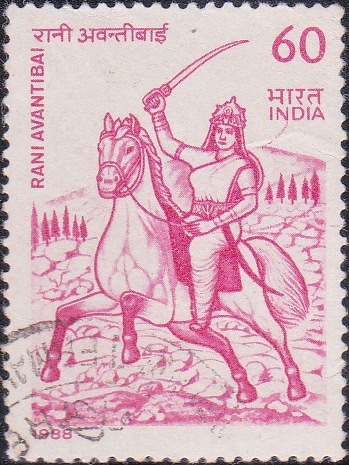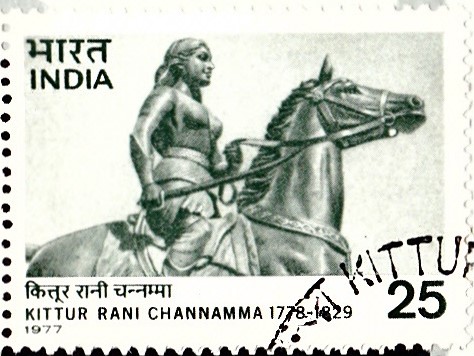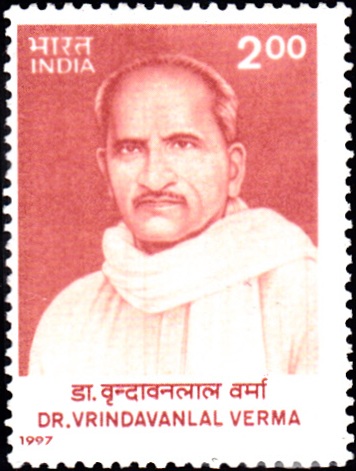
Jhalkari Bai
A commemorative postage stamp on Jhalkaribai, an woman warrior in army of Rani Lakshmibai of Jhansi, played an important role in the Indian Rebellion of 1857 :
 Issued by India
Issued by India
Issued on Jul 22, 2001
Issued for : The Department of Posts is happy to release a postage stamp in ho

nour of Jhalkari Bai.
Credits :
Stamp & FDC : Kamleshwar Singh
Cancellation : Alka Sharma
Type : Stamp, Mint Condition
Colour : Four Colour
Denomination : 400 Paise
Overall size : 2.90 x 3.91 cms.
Printing Size : 2.54 x 3.55 cms.
Perforation : 13 x 13
Paper : Imported Unwatermarked Stamp Paper
Stamps Printed : 0.4 million
Number per issue sheet : 40
Printing Process : Photo Offset
Printer : Eagle Press Pvt. Ltd.
Name : Jhalkaribai
Born on Nov 22, 1830 at Bhojla Village, near Jhansi, Uttar Pradesh, India
Died on Apr 4, 1858 at Gwalior, Madhya Pradesh, India
About :
- Resentment against the British rule in India had started immediately after its inception. However, it took almost a century for the long-simmering discontent to take the form of a mass-based reaction. The uprising, when it finally occurred in 1857, drew into its fold people from all walks of life – the peasants and tribals, the zamindars and chieftains, the sepoys and princes, and even the sanyasis and faqirs. The British military machine ultimately succeeded in suppressing the revolt. Though the colonial rulers dismissively dubbed it as the ‘Sepoy Mutiny‘, implying that it was merely an uprising of the disgruntled sepoys, the central character of the struggle was clearly that of a nationalist liberation movement. Modern historians have rightly rechristened the ‘Mutiny’ as the First War of Independence of India.
- The saga of Jhalkari Bai, a courageous woman who came from a humble background and played a valiant role in the Jhansi theatre of the revolt of 1857 is illustrative of the seriousness of discontent among the common people against the colonial dominance and the extent of popular participation in the struggle.
- Though the recorded history does not reveal much about the antecedents or heroic exploits of Jhalkari Bai, she is a living memory in the folklore of the Bundelkhand region (which was part of the erstwhile state of Jhansi) even today. Jhalkari was a village girl who had to take charge of the household chores in her childhood itself, following the early loss of her mother. It is said that she once had an encounter with a tiger while collecting firewood in the jungle and killed it with her axe. Jhalkari also bore an uncanny resemblance to Rani Lakshmi Bai of Jhansi, because of which the Rani took a special liking to her and inducted her into the women’s wing of her army.
- Meanwhile, discontent against the British policies was brewing in Jhansi also. The child adopted by Gangadhar Rao, the late King of Jhansi and husband of Rani Lakshmi Bai, was not recognised by the British as the legitimate heir to the throne, and the state was taken over under the ‘Doctrine of Lapse‘. The people of Jhansi resented this annexation. They rallied around Rani Lakshmi Bai and resolved to take up arms to uphold the independence of their state. In 1858, there were several attacks on the Jhansi fort by the British and their native allies. The Rani marshalled her forces well and repulsed their attacks. The ever loyal Jhalkari Bai must have been a pillar of strength for the queen in those trying times. It is said that when the fall of the fortress became imminent, Jhalkari Bai and some generals convinced Lakshmi Bai to escape quietly with a handful of supporters. In a ploy to deceive the British, Jhalkari dressed up like the Rani and took command of the army. The British found out the truth too late, as the Rani had covered a considerable distance by then. Though Jhalkari Bai was forced to surrender, it is believed that the British military officers, who were impressed by her loyalty, courage and fighting prowess treated her with respect and freed her.
- Text : Based on material furnished by the sponsors.







